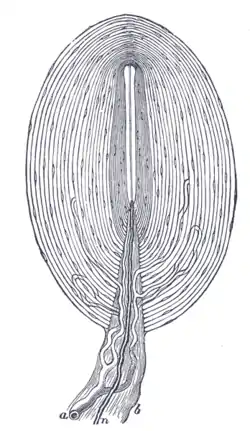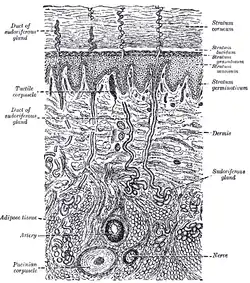Pacinian corpuscle
Pacinian corpuscle or lamellar corpuscle or Vater-Pacini corpuscle; is one of the four major types of mechanoreceptors (specialized nerve ending with adventitious tissue for mechanical sensation) found in mammalian skin. This type of mechanoreceptor is found in both glabrous (hairless) and hirsute (hairy) skins, viscera, joints and attached to periosteum of bone, primarily responsible for sensitivity to vibration.[1] Few of them are also sensitive to quasi-static or low frequency pressure stimulus.[2] Most of them respond only to sudden disturbances and are especially sensitive to vibration of few hundreds of Hz.[3] The vibrational role may be used for detecting surface texture, e.g., rough vs. smooth. Most of the Pacinian corpuscles act as rapidly adapting mechanoreceptors. Groups of corpuscles respond to pressure changes, e.g. on grasping or releasing an object.
| Pacinian corpuscle | |
|---|---|
 Pacinian corpuscle, with its system of capsules and central cavity. a. Arterial twig, ending in capillaries, which form loops in some of the intercapsular spaces, and one penetrates to the central capsule. b. The fibrous tissue of the stalk. n. Nerve tube advancing to the central capsule, there losing its white matter and stretching along the axis to the opposite end, where it ends by a tuberculated enlargement. | |
 Pacinian corpuscle labeled at bottom | |
| Details | |
| Location | Skin |
| Identifiers | |
| Latin | corpusculum Pacinian |
| MeSH | D010141 |
| TH | H3.11.06.0.00009 |
| FMA | 83604 |
| Anatomical terms of microanatomy | |
Structure
Pacinian corpuscles are larger and fewer in number than Meissner's corpuscle, Merkel cells and Ruffini's corpuscles.[4]
The Pacinian corpuscle is approximately oval-cylindrical-shaped and 1 mm in length. The entire corpuscle is wrapped by a layer of connective tissue. Its capsule consists of 20 to 60 concentric lamellae (hence the alternative lamellar corpuscle) including fibroblasts and fibrous connective tissue (mainly Type IV and Type II collagen network), separated by gelatinous material, more than 92% of which is water.[5]
Function
Pacinian corpuscles are rapidly adapting (phasic) receptors that detect gross pressure changes and vibrations in the skin. Any deformation in the corpuscle causes action potentials to be generated by opening pressure-sensitive sodium ion channels in the axon membrane. This allows sodium ions to flow into the cell, creating a receptor potential.
These corpuscles are especially sensitive to vibrations, which they can sense even centimeters away.[4] Their optimal sensitivity is 250 Hz, and this is the frequency range generated upon fingertips by textures made of features smaller than 1 µm.[6][7] Pacinian corpuscles respond when the skin is rapidly indented but not when the pressure is steady, due to the layers of connective tissue that cover the nerve ending.[4] It is thought that they respond to high-velocity changes in joint position. They have also been implicated in detecting the location of touch sensations on handheld tools.[8]
Pacinian corpuscles have a large receptive field on the skin's surface with an especially sensitive center.[4]
Mechanism
Pacinian corpuscles sense stimuli due to the deformation of their lamellae, which press on the membrane of the sensory neuron and causes it to bend or stretch.[9] When the lamellae are deformed, due to either pressure or release of pressure, a generator potential is created as it physically deforms the plasma membrane of the receptive area of the neuron, making it "leak" Na+ ions. If this potential reaches a certain threshold, nerve impulses or action potentials are formed by pressure-sensitive sodium channels at the first node of Ranvier, the first node of the myelinated section of the neurite inside the capsule. This impulse is now transferred along the axon with the use of sodium channels and sodium/potassium pumps in the axon membrane.
Once the receptive area of the neurite is depolarized, it will depolarize the first node of Ranvier; however, as it is a rapidly adapting fibre, this does not carry on indefinitely, and the signal propagation ceases. This is a graded response, meaning that the greater the deformation, the greater the generator potential. This information is encoded in the frequency of impulses, since a bigger or faster deformation induces a higher impulse frequency. Action potentials are formed when the skin is rapidly distorted but not when pressure is continuous because of the mechanical filtering of the stimulus in the lamellar structure. The frequencies of the impulses decrease quickly and soon stop due to the relaxation of the inner layers of connective tissue that cover the nerve ending.
Discovery
Pacinian corpuscle is the first cellular level sensory receptor ever observed by a biologist or an anatomist. It is first discovered by German anatomist and botanist D. Abraham Vater and his student Johannes Gottlieb Lehmann in around 1717 to 1719 and mostly named after Italian anatomist Filippo Pacini for its third re-discovery in 1830. In between around 1820, it is also re-discovered by John Shekleton, a curator of the Royal College of Surgeons in Ireland. Similar to Pacinian corpuscles Herbst corpuscles and Grandry corpuscles are found in avian species.[2]
Additional images
 Diagrammatic sectional view of the skin (magnified)
Diagrammatic sectional view of the skin (magnified) Schema (German)
Schema (German) Light micrograph showing three corpuscles in the center of the field
Light micrograph showing three corpuscles in the center of the field Micrograph of a Pacinian corpuscle
Micrograph of a Pacinian corpuscle
See also
- Pallesthesia
- List of human anatomical parts named after people
- Pacinian neuroma – a very rare benign tumor of Pacinian corpuscles
- Rayleigh wave#Possible detection by animals
References
- Biswas, Abhijit; Manivannan, M.; Srinivasan, Mandyam A. (2015). "Multiscale Layered Biomechanical Model of the Pacinian Corpuscle". IEEE Transactions on Haptics. 8 (1): 31–42. doi:10.1109/TOH.2014.2369416. PMID 25398182. S2CID 24658742.
- Biswas, Abhijit (2015). Characterization and Modeling of Vibrotactile Sensitivity Threshold of Human Finger Pad and the Pacinian Corpuscle (PhD). Indian Institute of Technology Madras, Tamil Nadu, India. doi:10.13140/RG.2.2.18103.11687.
- Biswas, Abhijit; Manivannan, M.; Srinivasan, Mandyam A. (2015). "Vibrotactile Sensitivity Threshold: Nonlinear Stochastic Mechanotransduction Model of the Pacinian Corpuscle". IEEE Transactions on Haptics. 8 (1): 102–113. doi:10.1109/TOH.2014.2369422. PMID 25398183. S2CID 15326972.
- Kandel, Eric R.; Schwartz, James H.; Jessell, Thomas M., eds. (2000). Principles of neural science. New York: McGraw-Hill, Health Professions Division. ISBN 0-8385-7701-6.
- Cherepnov, V.L.; Chadaeva, N.I. (1981). "Some characteristics of soluble proteins of Pacinian corpuscles". Bulletin of Experimental Biology and Medicine. 91 (3): 346–348. doi:10.1007/BF00839370. PMID 7248510. S2CID 26734354.
- Scheibert, J; Leurent, S; Prevost, A; Debrégeas, G (2009). "The role of fingerprints in the coding of tactile information probed with a biomimetic sensor". Science. 323 (5920): 1503–6. arXiv:0911.4885. Bibcode:2009Sci...323.1503S. doi:10.1126/science.1166467. PMID 19179493. S2CID 14459552.
- Skedung, Lisa, Martin Arvidsson, Jun Young Chung, Christopher M. Stafford, Birgitta Berglund, and Mark W. Rutland. 2013. "Feeling Small: Exploring the Tactile Perception Limits." Sci. Rep. 3 (September 12). doi:10.1038/srep02617.
- Sima, Richard (23 December 2019). "The Brain Senses Touch beyond the Body". Scientific American. Retrieved 17 February 2020.
- Klein, Stephen B.; Michael Thorne, B. (2006-10-03). Biological Psychology. ISBN 9780716799221.